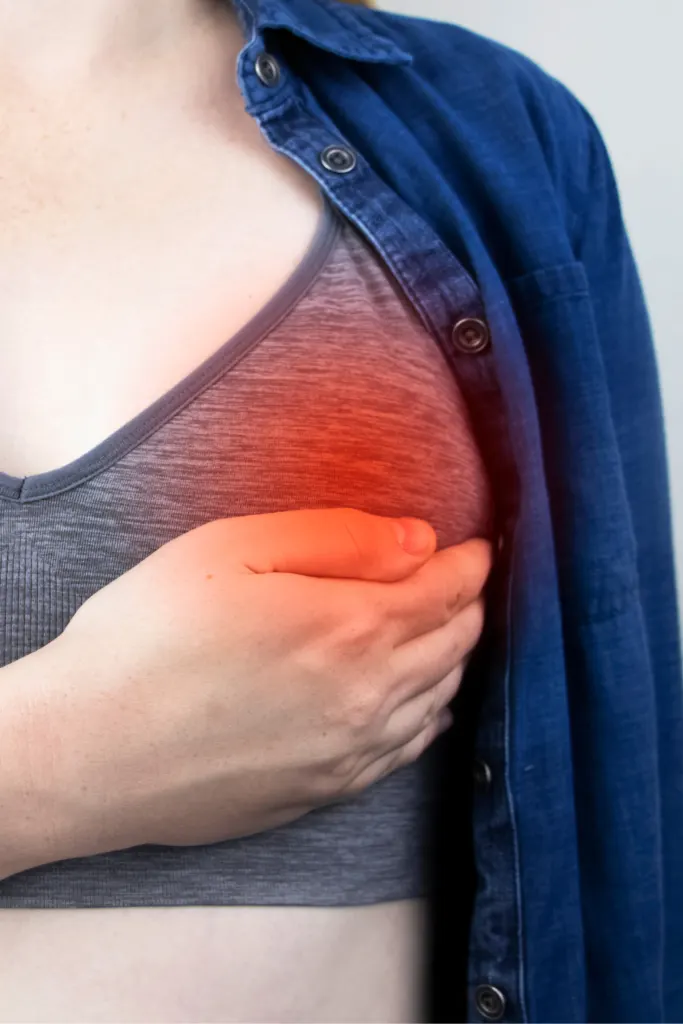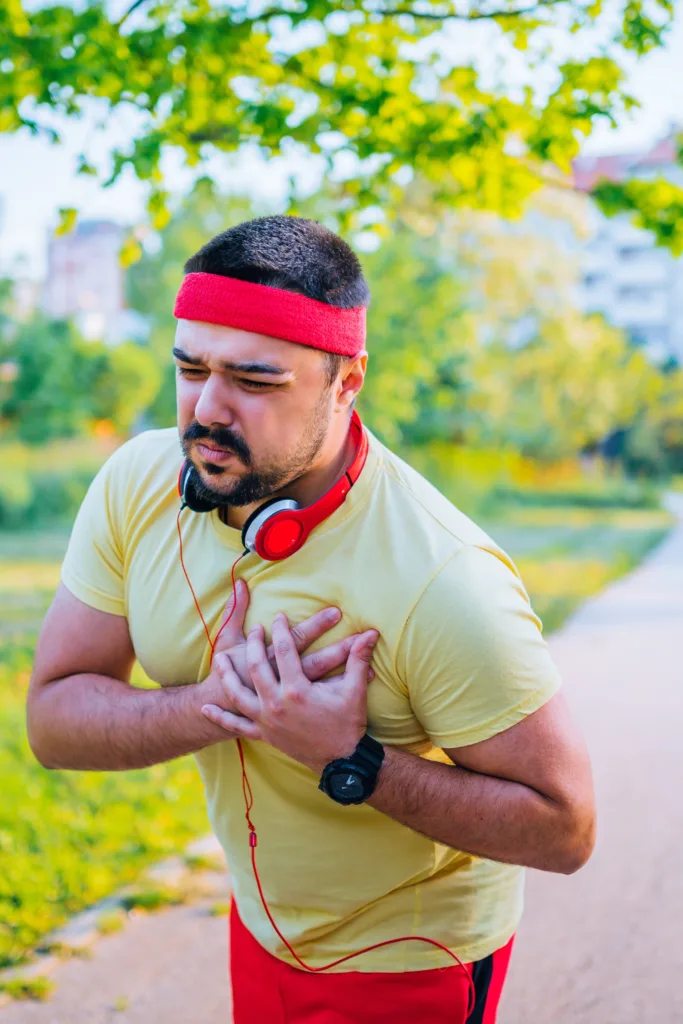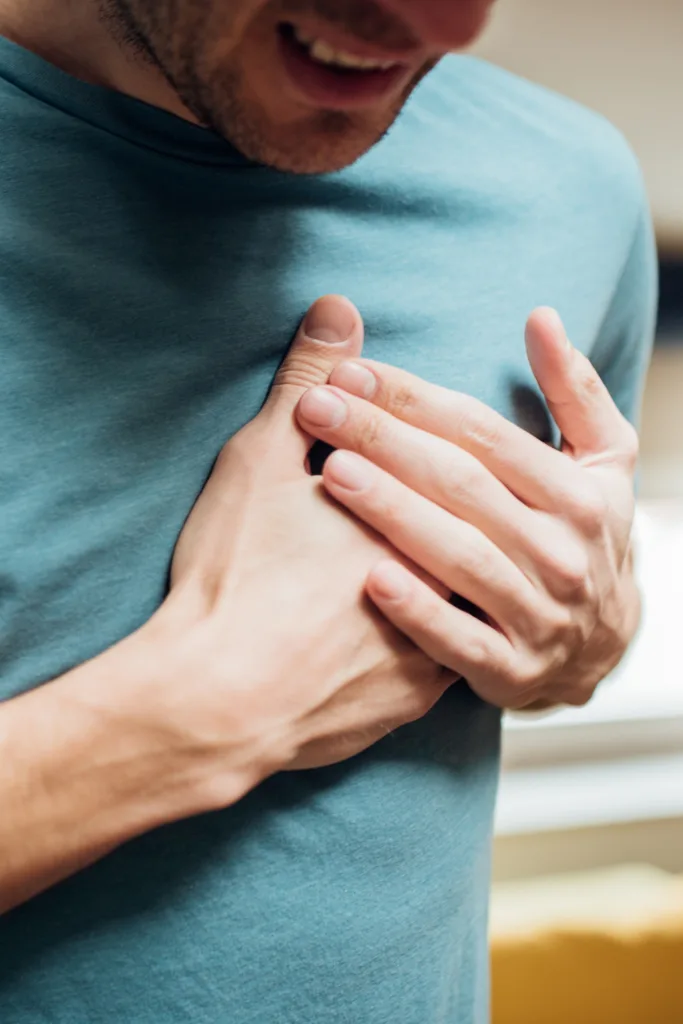Chafing is a common problem for many runners, whether it be a blister on your foot or chafing in your armpits or between your legs.
When your t-shirt rubs against your nipples, this can cause chafing and friction against the nipples which results in a condition called jogger’s nipple (also known as runner’s nipple).
This chafing can cause rather unfortunate consequences such as sore and bleeding nipples.
The good news is jogger’s nipple can be easily treated.
In this guide we’ll explore:
- What is jogger’s nipple?
- What are the symptoms of jogger’s nipple?
- What causes jogger’s nipple?
- How long does jogger’s nipple last?
- Who is at risk of jogger’s nipple?
- How to treat jogger’s nipple
- How to prevent jogger’s nipple
Ready?
Let’s go!

What is jogger’s nipple?
Jogger’s nipple is a rather unfortunate side effect of chafing – that is the chafing that occurs when your t-shirt rubs against your nipples.
This chafing can cause a friction burn which can then lead to sore or even bleeding nipples.
According to a 2014 study on sports-related dermatoses, the most prevalent injuries were:
- Blisters (50%)
- Chafing (42.1%)
- Calluses (34.2%)
- Onychomadesis (31.5%)
- Tinea pedis (18.4%)
- Onychocryptosis (14.5%)
- Cheilitis simplex (14.5%)
The study noted that amongst athletes running more than 64km per week, jogger’s nipple along with other conditions like calluses, chapped lips and athlete’s foot were significantly more frequent.
Related: Taste blood when running? 7 causes + how to prevent it
What are the symptoms of jogger’s nipple?
Symptoms of jogger’s nipple can range from mild discomfort to pain in the nipples.
The main symptoms of jogger’s nipple are:
- Redness of the nipples
- Raw, sore nipples, especially during a run
- Nipples that feel sensitive or sore to the touch
- Pain in the nipples
- Dry and cracked nipples
- Bleeding nipples
Related: Neck and shoulder pain when running: 6 quick fixes

What causes jogger’s nipple?
The main cause of jogger’s nipple is chafing.
The skin around your nipple is thin, delicate and sensitive, so it is more susceptible to chafing and friction.
Jogger’s nipple can occur at any time of the year.
Wearing a sweaty t-shirt during the hot summer months can cause it, especially if you wear a cotton t-shirt as they get heavy with sweat.
Running during the winter months when your nipples are erect can also cause jogger’s nipple.
If you run long distances you are also more susceptible to jogger’s nipple.
Related: Hip pain after running: 8 causes + how to prevent it
How long does jogger’s nipple last?
The healing time will depend on the severity of your symptoms, but generally jogger’s nipple clears up within one week.
Related: Lower back pain after running: Causes + 7 ways to prevent it
Who is at risk of jogger’s nipple?
You are more at risk of jogger’s nipple if you:
- Wear cotton t-shirts when you run
- Run for long distances
- Run wearing a sweaty t-shirt
- Are overweight
- Wear the incorrect sports bra
Related: Runner’s toe: Causes + 6 ways to prevent it

How to treat jogger’s nipple
#1 Rest
As soon as you start to experience soreness and pain in your nipples, rest and take a break from running until your symptoms start to get better.
#2 Clean your nipples
As soon as you start to feel pain and discomfort, stop your run and when you get home gently clean your nipple with mild soap and warm water.
Stay away from strong chemicals or highly perfumed cleansers as these could irritate the skin around your nipple even more.
Once you have cleaned the area, carefully dry it by patting it with a dry, clean paper towel.
#3 Apply petroleum jelly
Apply petroleum jelly or Vaseline to your nipples as this will help to soothe and protect the skin on and around the nipple.
#4 Apply cream
Steroid creams such as hydrocortisone can help reduce swelling and inflammation.
Antibiotic creams can also help to heal cracked skin around the nipples.
If in doubt, speak to your healthcare professional.
#5 Cover your nipples
Finally, place breathable gauze over your nipples then cover with sports tape to keep the area protected as it heals.
Related: Knee brace for running: When to wear one + where to buy

How to prevent jogger’s nipple
Now you know more about the causes of jogger’s nipple, here are 5 ways to prevent it.
#1 Wear the correct sports bra
For the ladies, wearing the correct sports bra will help to prevent any chafing around the breasts and nipples.
There are many types of sports bras on the market nowadays, so it’s even more important to choose a bra that is suitable for you and your needs.
The four key things you need to look for when choosing a sports bra are:
- Support level. Select the right level of support. For running, high impact sports bras are normally recommended.
- Compression or encapsulation. Whether you wear a compression or encapsulation bra will depend on the size and shape of your breasts. Compression bras are normally recommended for small breasts as they compress the breasts against the chest. Encapsulation bras are normally recommended for large breasts as they keep the breasts in separate cups. A frew bra styles offer compression and encapsulation features.
- Strap width. Wide straps will help to provide better support and will prevent the bra from digging into the skin when exercising.
- Material. Breathable and comfortable materials are preferable. Any bras with lots of seams may cause chafing so opt for seamless bras where possible, especially in the cup area.
#2 Cover your nipples
Cover your nipples with band aids, plasters, sports tape or bandages when running to help minimise the chafing and irritation and provide better protection of your nipples.
Be careful not to use normal tape as this may damage the skin around your nipples when applied and taken off the skin.
#3 Apply petroleum jelly to your nipples
Lubricants like petroleum jelly and Vaseline can help to prevent chafing when applied before a run.
There are some anti-chafing creams and lubricants on the market that are made specifically for runners, so research these as well if you think they’ll benefit you.
Talcum powder also helps to keep nipples dry.
#4 Wear the right fabrics
Opt for running clothes made of sweat-wicking fabrics like polyester and Merino wool.
These types of materials are designed to be lighter and moisture-wicking so they help to prevent chafing and irritation.
These clothes also fit tighter meaning there’s less friction against your chest and nipples.
#5 Reduce your weekly mileage
If you regularly experience jogger’s nipple and you run long distances then it may be a sign that you need to dial your training down a little.
According to a 2014 study, there was a significant association between the weekly running distance and the probability of skin lesions.
Reduce your weekly mileage to give your nipples time to heal.
Related: Why do my legs itch when I run? How to prevent runner’s itch
- 5 things I wish I’d known before returning to running - March 3, 2024
- Running 20 minutes a day: Benefits + how to start - January 27, 2024
- How to run your first 2 hour half marathon - January 16, 2024
